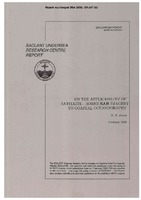| dc.contributor.author | Essen, Heinz-Hermann | |
| dc.date.accessioned | 2018-10-11T14:07:49Z | |
| dc.date.available | 2018-10-11T14:07:49Z | |
| dc.date.issued | 1996/02 | |
| dc.identifier | 10643 | |
| dc.identifier.govdoc | SR-247 | |
| dc.identifier.uri | http://hdl.handle.net/20.500.12489/362 | |
| dc.description.abstract | Synthetic aperture radar (SAR) images have been acquired from the first European Space Agency (ESA) remote sensing satellite ERS- 1. The mesoscale feature images are from Norwegian coastal waters and the Mediterranean (Elba and Sicily areas). Theories are tested for their ability to explain the observed variability of the radar-cross section. By means of empirical models, developed for the ERS-I scatterometer, wind speeds are extracted from the SAR images and compared with measured data. Theories of SAR imaging and boundary-layer stability are applied to investigating the imaging of thermal fronts. The possibility of determining surface-current variability from SAR images is emphasized. The theoretical approach is based on the modulation of small-scale scattering waves by underlying currents. | |
| dc.format | 60 p. : ill. ; 33 fig. | |
| dc.language | English | |
| dc.publisher | NATO. SACLANTCEN | |
| dc.relation.ispartofseries | ADB212369 | |
| dc.subject | Synthetic Aperture Radar (SAR) | |
| dc.subject | Remote sensing | |
| dc.subject | Coastal oceanography | |
| dc.subject | Norwegian Sea | |
| dc.subject | Tyrrhenian Sea | |
| dc.subject | Sicily | |
| dc.title | On the applicability of satellite-borne SAR imagery to coastal oceanography | |
| dc.type | Scientific Report (SR) | |
